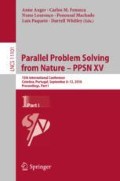Abstract
For any population-based algorithm, the initialization of the population is a very important step. In Genetic Programming (GP), in particular, initialization is known to play a crucial role - traditionally, a wide variety of trees of various sizes and shapes are desirable. In this paper, we propose an advancement of a previously conceived Evolutionary Demes Despeciation Algorithm (EDDA), inspired by the biological phenomenon of demes despeciation. In the pioneer design of EDDA, the initial population is generated using the best individuals obtained from a set of independent subpopulations (demes), which are evolved for a few generations, by means of conceptually different evolutionary algorithms - some use standard syntax-based GP and others use a semantics-based GP system. The new technique we propose here (EDDA-V2), imposes more diverse evolutionary conditions - each deme evolves using a distinct random sample of training data instances and input features. Experimental results show that EDDA-V2 is a feasible initialization technique: populations converge towards solutions with comparable or even better generalization ability with respect to the ones initialized with EDDA, by using significantly reduced computational time.
Access this chapter
Tax calculation will be finalised at checkout
Purchases are for personal use only
References
Archetti, F., Lanzeni, S., Messina, E., Vanneschi, L.: Genetic programming for computational pharmacokinetics in drug discovery and development. Genet. Program. Evol. Mach. 8(4), 413–432 (2007)
Beadle, L.C.J.: Semantic and structural analysis of genetic programming. Ph.D. thesis, University of Kent, Canterbury, July 2009
Beadle, L.C.J., Johnson, C.G.: Semantic analysis of program initialisation in genetic programming. Genet. Program. Evol. Mach. 10(3), 307–337 (2009)
Castelli, M., Manzoni, L., Vanneschi, L., Silva, S., Popovič, A.: Self-tuning geometric semantic genetic programming. Genet. Program. Evol. Mach. 17(1), 55–74 (2016)
Castelli, M., Silva, S., Vanneschi, L.: A C++ framework for geometric semantic genetic programming. Genet. Program. Evol. Mach. 16(1), 73–81 (2015)
Castelli, M., Vanneschi, L., Felice, M.D.: Forecasting short-term electricity consumption using a semantics-based genetic programming framework: the south italy case. Energy Econ. 47, 37–41 (2015)
Koza, J.R.: Genetic Programming: On the Programming of Computers by Means of Natural Selection. MIT Press, Cambridge (1992)
Moraglio, A., Krawiec, K., Johnson, C.G.: Geometric semantic genetic programming. In: Coello, C.A.C., Cutello, V., Deb, K., Forrest, S., Nicosia, G., Pavone, M. (eds.) PPSN 2012. LNCS, vol. 7491, pp. 21–31. Springer, Heidelberg (2012). https://doi.org/10.1007/978-3-642-32937-1_3
Oliveira, L.O.V., Otero, F.E., Pappa, G.L.: A dispersion operator for geometric semantic genetic programming. In: Proceedings of the Genetic and Evolutionary Computation Conference 2016, GECCO 2016, pp. 773–780. ACM (2016)
Pawlak, T.P., Wieloch, B., Krawiec, K.: Review and comparative analysis of geometric semantic crossovers. Genet. Program. Evol. Mach. 16(3), 351–386 (2015)
Taylor, E.B., Boughman, J.W., Groenenboom, M., Sniatynski, M., Schluter, D., Gow, J.L.: Speciation in reverse: morphological and genetic evidence of the collapse of a three-spined stickleback (gasterosteus aculeatus) species pair. Mol. Ecol. 15(2), 343–355 (2006)
Tomassini, M., Vanneschi, L., Collard, P., Clergue, M.: A study of fitness distance correlation as a difficulty measure in genetic programming. Evol. Comput. 13(2), 213–239 (2005)
Vanneschi, L.: An introduction to geometric semantic genetic programming. In: Schütze, O., Trujillo, L., Legrand, P., Maldonado, Y. (eds.) NEO 2015. SCI, vol. 663, pp. 3–42. Springer, Cham (2017). https://doi.org/10.1007/978-3-319-44003-3_1
Vanneschi, L., Bakurov, I., Castelli, M.: An initialization technique for geometric semantic GP based on demes evolution and despeciation. In: 2017 IEEE Congress on Evolutionary Computation, CEC 2017, Donostia, San Sebastián, Spain, 5–8 June 2017, pp. 113–120 (2017)
Vanneschi, L., Castelli, M., Silva, S.: A survey of semantic methods in genetic programming. Genet. Program. Evol. Mach. 15(2), 195–214 (2014)
Vanneschi, L., Silva, S., Castelli, M., Manzoni, L.: Geometric semantic genetic programming for real life applications. In: Riolo, R., Moore, J.H., Kotanchek, M. (eds.) Genetic Programming Theory and Practice XI. GEC, pp. 191–209. Springer, New York (2014). https://doi.org/10.1007/978-1-4939-0375-7_11
Wilson, D.S.: Structured demes and the evolution of group-advantageous traits. Am. Nat. 111(977), 157–185 (1977). https://doi.org/10.1086/283146
Author information
Authors and Affiliations
Corresponding author
Editor information
Editors and Affiliations
Rights and permissions
Copyright information
© 2018 Springer Nature Switzerland AG
About this paper
Cite this paper
Bakurov, I., Vanneschi, L., Castelli, M., Fontanella, F. (2018). EDDA-V2 – An Improvement of the Evolutionary Demes Despeciation Algorithm. In: Auger, A., Fonseca, C., Lourenço, N., Machado, P., Paquete, L., Whitley, D. (eds) Parallel Problem Solving from Nature – PPSN XV. PPSN 2018. Lecture Notes in Computer Science(), vol 11101. Springer, Cham. https://doi.org/10.1007/978-3-319-99253-2_15
Download citation
DOI: https://doi.org/10.1007/978-3-319-99253-2_15
Published:
Publisher Name: Springer, Cham
Print ISBN: 978-3-319-99252-5
Online ISBN: 978-3-319-99253-2
eBook Packages: Computer ScienceComputer Science (R0)

